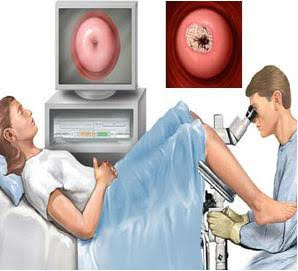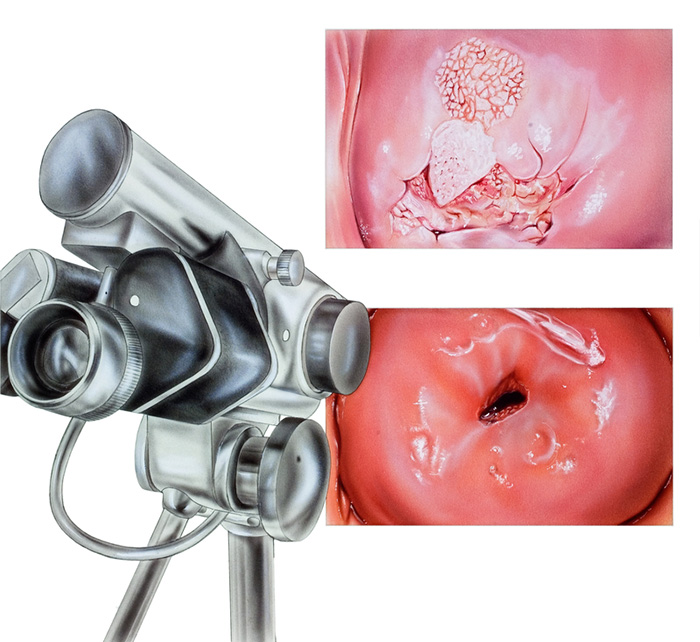Screening for cervical cancer (with Pap test and/or human papillomavirus test) is an important part of keeping healthy and preventing cervical cancer. If the results of your screening test are abnormal, further testing is needed to confirm the result and determine the severity of the abnormality. Usually, a colposcopy is recommended in this case.
During this procedure, your doctor checks your cervix with a colposcope. A biopsy may also be performed during the colposcopy. Colposcopy (looking at the cervix) and biopsy (taking small pieces of tissue during colposcopy for examination in the laboratory) may be done at the same time.
Not all women with an abnormal cervical screening test need to be treated. Colposcopy with or without biopsy helps determine if treatment is needed.

Why do I need a colposcopy?
Colposcopy is used to follow up on abnormal results of screening tests for cervical cancer (e.g., Pap smear, human papillomavirus (HPV) test) or abnormal areas on the cervix, vagina, or vulva. Your Pap smear may be abnormal if you have a precancerous lesion or cancer on the cervix, which is often caused by HPV infection of the cervix.
Colposcopy is a procedure in which the cervix is viewed with a magnifying glass. Acetic acid (i.e., vinegar) is applied to the cervix to mark the cells and allow the doctor to better see where the abnormal cells are located and how large the abnormal areas are. Based on the size, type and location of the abnormal cells, the doctor can determine which area or areas should be biopsied. This will help determine how severe the abnormality is, as well as what treatment is needed. If diagnosed and treated early, precancerous lesions usually do not develop into cervical cancer.
Preparation for colposcopy
Before your colposcopy appointment, you should avoid all vaginal applications (e.g., creams, lotions). Colposcopy can be performed while you are menstruating, but if you have heavy vaginal bleeding on the day of the exam, your doctor may postpone the procedure.
If you are taking blood thinners (aspirin, warfarin, heparin, clopidogrel), your doctor must be informed in advance. These medications may increase bleeding if a biopsy is performed during colposcopy. If you think you are pregnant or are pregnant, your doctor should also be informed. Colposcopy is safe during pregnancy, but usually your doctor will not perform a cervical biopsy if you are pregnant.
Colposcopy Procedure
Colposcopy can be performed by a specialist doctor. Colposcopy takes about 5 to 10 minutes, can be performed in an examination room, and causes little discomfort. A colposcopy is performed on a gynecologic exam table, similar to a routine gynecologic exam. Your doctor will use a sterile instrument called a speculum to open your vagina and view your cervix. If necessary, your doctor will repeat the Pap Smear and then look at your cervix with a colposcope. The colposcope is like a microscope and does not come in contact with your skin.
Your doctor will apply a solution called acetic acid (vinegar) to your cervix. This solution helps mark the abnormal areas and makes them easier to see with the colposcope. You may feel cold or a slight burning sensation when this solution is used, but it will not hurt you. During a colposcopy, your doctor may take a small piece of abnormal tissue (biopsy) from your cervix or vagina. Performing biopsy does not mean you have precancerous lesions. Anesthesia is not usually used for the biopsy because the biopsy causes only mild discomfort or cramping. The tissue sample is sent to a laboratory and examined by pathologists under a microscope.
Some women also need to have a biopsy of the inner cervix taken during colposcopy, which is called endocervical curettage (ECC). ECC is not performed in pregnant women because it can harm the pregnancy. ECC can cause cramping pain.
After colposcopy
If your doctor has taken a biopsy of your cervix, you may have vaginal bleeding after colposcopy. If your doctor used Monsel's solution during the procedure, you may have a brown or black vaginal discharge that looks like coffee grounds. This discharge will go away within a few days. Most women can return to their daily routine soon after the colposcopy. Some women may experience mild pain or cramping, but this usually subsides within one to two hours. Do not apply anything to your vagina after the procedure (creams, lotions, tampons, etc.) and do not have sexual intercourse for 48 hours after the biopsy. If you have had a biopsy, ask your doctor when you will receive the results (usually within 7-14 days). In most cases, the results of the biopsy will determine if further testing and treatment are needed.
If you do not hear from your doctor, do not assume that the biopsy results are normal: Call and ask about the results. Most women need follow-up (cervical cancer screening (Pap smear) and/or repeat colposcopy) within six months.
When should I go to the hospital after a colposcopy?
Call your doctor if you experience any of the following symptoms after colposcopy:
- Heavy vaginal bleeding (lasting more than two hours and filling a large pad every hour).
- Vaginal bleeding that lasts longer than seven days.
- Foul-smelling discharge from the vagina; note that brown/black discharge is normal for the first few days.
- Pain or cramping in the groin area that does not improve with pain medication
- Fever of more than 38°C





